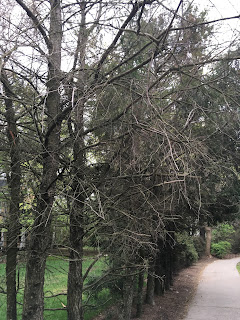 |
| Our hemlocks need pesticide spraying to survive |
When I was researching The Sustainable-Enough Garden, I interviewed environmentalist Ellie Goldberg of Green Newton for advice on whether this treatment was consistent with an environmentally friendly approach. She didn’t favor the idea. She’d taken down her hemlocks rather than spray them. At the time I wasn’t ready to give up on mine.
But this spring I’ve decided to follow Ellie’s example. Perhaps learning about neonicotinoid pesticide residue on nursery-grown plants has made me more sensitive to the effects of my actions on the insects around me.
 |
| A praying mantis keeps garden insects in balance--photo by Scott Robinson |
Our eastern hemlocks (Tsuga canadensis) were planted by previous owners in two corners of the yard and have grown to about 30 feet tall. The adelgids are tiny imported insects that kill hemlocks by sucking their sap. That’s why you see so many hemlock skeletons and trees gradually losing their needles.
 |
| Hemlocks succumbing to woolly adelgid damage |
You can recognize infested trees by the lines of white egg cases along the twigs that look like tiny cotton balls.
 |
| Telltale white dots along the twigs are adelgid egg cases |
Leaving the hemlocks untreated wasn’t an option, because untreated trees die within a few years of infestation, and there’s no escaping the ubiquitous adelgids. I didn’t want to provide a staging area for further adelgid depredations in my neighborhood. I wanted to keep the hemlocks alive because I thought that as native trees, they must be hosting native animals in the yard.
 |
| A hemlock (not ours) shelters young Eastern screech owls--photo by Matt MacGillivray |
So I signed up to have our hemlocks sprayed with horticultural oil. My justification for using the pesticide was that the adelgid is a nonnative introduction with no North American predators.
The horticultural oil application involves spraying a mist of refined petroleum-derived oil combined with emulsifier into the hemlocks. The spray smothers the insects mechanically by coating them with oil rather than attacking their metabolism as many chemical pesticides do. When the oil dries on the trees in a few hours, it’s non-toxic. Horticultural oil was used on fruit trees as far back as ancient Greece, although back then they used plant oils rather than petroleum.
If it’s applied in very early spring when the adelgids are active but most other insects aren’t, horticultural oil comes close to targeting only the adelgids. But in practice, the timing never turns out right. It’s not the company’s fault; weather and scheduling get in the way. If they spray now, the oil will also suffocate insects I’m trying to foster in my yard.
 |
| Bees on swamp milkweed are welcome guests |
The only alternative is to remove the hemlocks. I asked arborist Kevin Newman’s team to cut them down in the next few weeks. I’m sad to do it, but it seems better than continuing to spray at the wrong time. To replace the food and shelter that the hemlocks have provided for wildlife, I'll need to plant other native trees or shrubs in their place.
Saddening to read that you are removing hemlocks. But glad to know that you are doing it for good. Your courage to cooperate with the environment is appreciable.
ReplyDelete